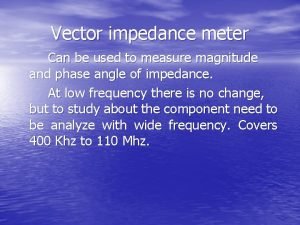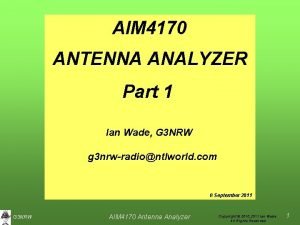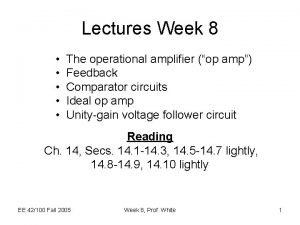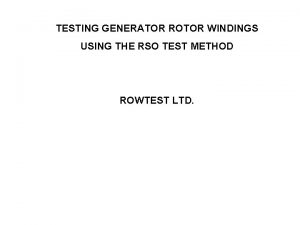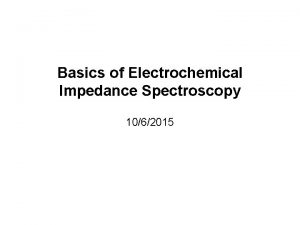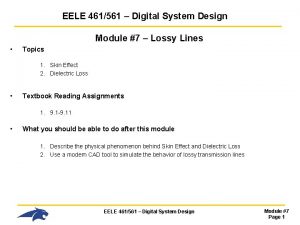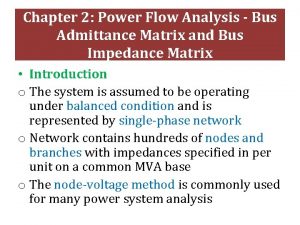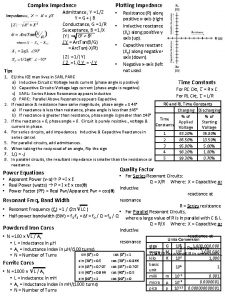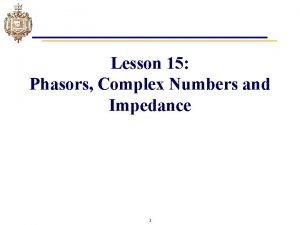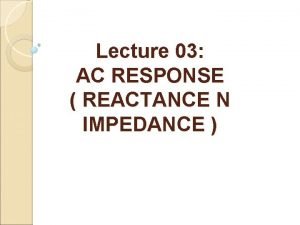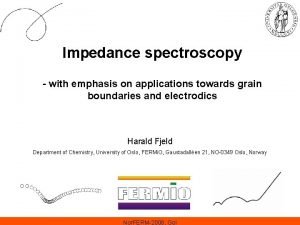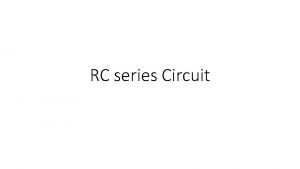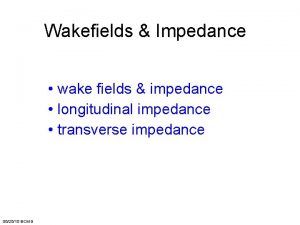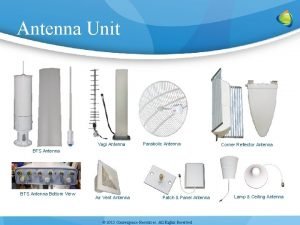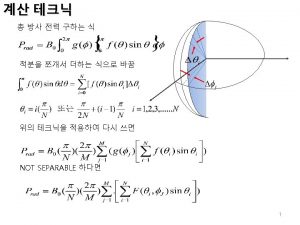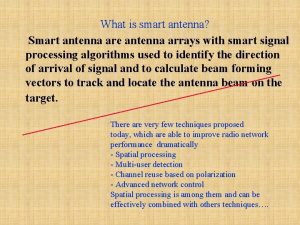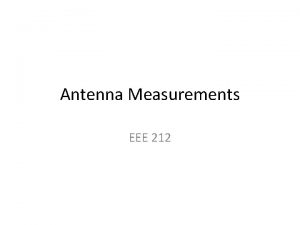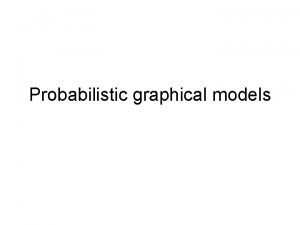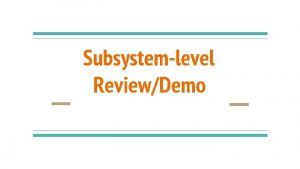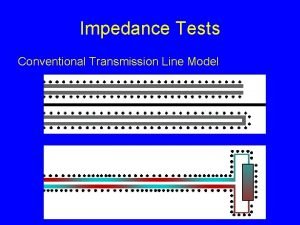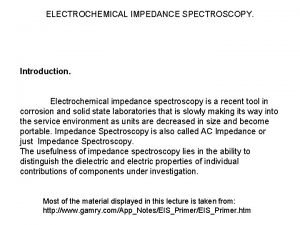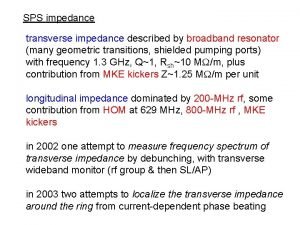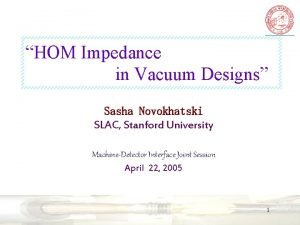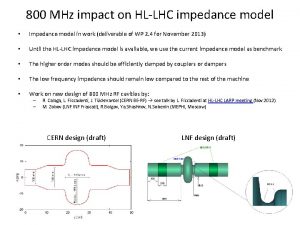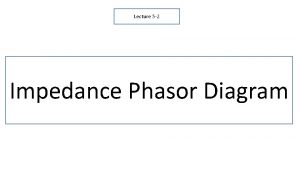MFJ226 ANTENNA ANALYZER GRAPHICAL IMPEDANCE ANTENNA ANALYZER REVIEWDEMO




















- Slides: 20

MFJ-226 ANTENNA ANALYZER GRAPHICAL IMPEDANCE ANTENNA ANALYZER REVIEW/DEMO

MFJ VNA ANTENNA ANALYZER COVERS 1 TO 230 MHZ, 1 HZ RESOLUTION. • Frequency sweep plots: SWR, Impedance, Resistance, Reactance, Phase Angle, Complex Return Loss, Smith Chart • Sign of reactance • Amazing accuracy with OSL(Open-Short-Load) calibration. • You. Tube

INTRODUCTION • The MFJ-226 is part of the Times Technology Series of analyzers and is a compact single-port Vector Network Analyzer (VNA) that characterizes complex RF loads in 50 -Ohm systems with a high degree of accuracy. Packaged for portable use, it's easy to operate under a wide range of test conditions yet delivers many advanced features usually reserved for units costing much more. For example:

• MFJ-226 can compensate for phase rotation and losses in feedlines and test cables by using industry-standard Open/Short/Load (OSL) calibration setups. • MFJ-226 calculates true reactance sign (plus or minus), eliminating sign ambiguity. • The DDS stimulus generator provides continuous coverage from 1 MHz to 230 MHz. • The DDS accepts both step-tuning and direct-frequency entry via keypad. • The DDS features 1 -Hz frequency resolution with rock-solid stability • There are 32 memory files for capturing and downloading test data to a PC. • MFJ-226 has extremely simple power requirements (two AA batteries, Alkaline or Ni. MH). • All test results are displayed on a bright easy-to-read backlit LCD display. • The deluxe backlit keypad has large positive-action keys for easy field operation.

MODES AND FEATURES: • Single-Frequency Mode: Presents SWR, Complex Impedance (series and parallel), and S 11 scattering parameters (rectangular and polar). SWR is displayed in huge inch-high numbers clearly visible from several feet away. • Sweep-Frequency Mode: Graphically plots SWR, Impedance Magnitude (Z), Resistance (R), Reactance (X), Return Loss (RL, S 11), Phase Angle, and Smith Chart displays. A continuously tunable frequency marker pulls up precise alpha-numeric data. • Calibrate Mode: Walks you through the Open Short Load cal setups for both specific swept frequency measurements and for the unit's global calibration procedure. • Settings Mode: revision. • PC-Mode: Links the analyzer’s memory files to your PC through the serial data port. Offers useful options, shows battery condition and firmware

MFJ-226 TECHNICAL SPECIFICATIONS Frequency Range: Continuous, 1 MHz to 230 MHz Frequency Resolution: 1 Hz Test Port Termination Type-N Female Output Power >-10 d. Bm typical Harmonics -15 d. Bc typical LCD Display 128 x 64 resolution with backlight Dimensions 6. 5" (165 mm) x 3. 12" (80 mm) x 1. 25" (32 mm) Weight 10 oz with batteries and UHF adapter Power Two (2) AA cells, Alkaline or Ni. MH Computer Interface USB serial OSL Calibration Male-N Open, Short, and 50 -Ohm Load

SINGLE-FREQUENCY MENU • SWR, Frequency: The opening Single-Frequency screen displays SWR, and Frequency. Note that SWR readings appear in 1 -inch high numerals for easy viewing. A bargraph is also displayed for a visual representation of the SWR. When SWR opens, you will need to set the DDS generator to your desired test frequency.

SINGLE-FREQUENCY MENU • SWR Z R X Display: Displays similar to the first screen but has the SWR in smaller characters and also displays the Z R and X of the load. (Added in firmware V 01 R 02 and is not in earlier firmware. )

SINGLE-FREQUENCY MENU • Series Impedance: Displays the load's resistive and reactive component as two discrete elements connected in series. Also displays a true reactance sign and the inductive or capacitive value at the test frequency. This screen can also be used to determine the value of a capacitor in p. F or inductor in m. H at the operating frequency.

SINGLE-FREQUENCY MENU • Parallel Impedance: Displays the resistive and reactive components as two parallel elements. Also displays true reactance plus a finite inductive or capacitive value.

SINGLE-FREQUENCY MENU • S 11 Scattering Parameters: Displays Rectangular and Polar S 11 representations of the load.

SWEPT DATA SCREENS • SWR Screen: Each swept plot is identified in the upper left-hand corner, and the tunable marker frequency appears to the right. Use the Up/Down Arrow keys to step or scroll across the display's frequency range. The numerical test data corresponding to the marker location appears in the data window below (Ex. SWR is 1. 24: 1 at the marker).

SWEPT DATA SCREENS • Impedance Magnitude Screen (Z): This plot displays changes in Impedance Magnitude (Z) across the plot's frequency span.

SWEPT DATA SCREENS • Resistance Screen (R): The Resistance plot shows shifts in the load's resistive component as a function of frequency. Note that a corresponding reactance value and sign also appear.

SWEPT DATA SCREENS • Reactance Screen (+X or -X): The Reactance plot tracks both reactive value and displays sign to accurately identify if the load is capacitive or inductive. The resistive component is also shown.

SWEPT DATA SCREENS • Return Loss (S 11): The RL Plot shows the ratio of reflected power to forward power expressed in d. B across the frequency span. The higher the return loss ratio, the lower the load's SWR.

SWEPT DATA SCREENS • Phase Angle (Deg): When a test signal (incident wave) is transmitted to the load under test, the returning signal (reflected wave) will rarely return in phase. This screen plots the phase angle and amplitude ratio between the incident and reflected wave.

SWEPT DATA SCREENS • Smith Chart Screen: The Smith Chart is a very popular tool for visualizing complex impedance relationships in transmission lines and antenna systems as a function of frequency. Note that the Smith Chart frequency marker is displayed as a cross-hair that follows the load's impedance parameters in both the X and Y axis. Normalized numerical data defining the marker position is displayed to the righthand side of the plot.

MFJ-226 • Easy-to-read Backlit LCD Bright 2 1/2 inch LCD backlit screen is easy-to-read, even in direct sunlight. Use two AA batteries Use disposable Alkaline or rechargeable Ni. MH AA batteries (not included). Firmware upgradeable via USB port. Includes N-to-SO-239 adapter and 48 -inch mini USB to USB cable. 3 1/4 W x 6 1/2 H x 1 D inches. 9. 3 ounces. Looks, Feels, Performs Like a Professional Instrument MFJ-226 has both the hefty feel and advanced performance of a professional field-service instrument costing hundreds or even thousands of dollars more.

STUFF • New MFJ-227 - VHF/UHF 88 -226, 330 -500 MHZ • Demo PC Mode
 Vector impedance meter block diagram
Vector impedance meter block diagram Vector network analyzer block diagram
Vector network analyzer block diagram G3nrw
G3nrw Apa itu summing amplifier
Apa itu summing amplifier Line currents
Line currents Valvulo arterial impedance
Valvulo arterial impedance Generator
Generator Warburg impedance basics
Warburg impedance basics Characteristic impedance definition
Characteristic impedance definition Charge transfer resistance
Charge transfer resistance Attenuation constant formula
Attenuation constant formula Hakki formula
Hakki formula Zener diode current equation
Zener diode current equation Ybus matrix examples
Ybus matrix examples Y=1/z impedance
Y=1/z impedance 4733 zener diode
4733 zener diode Acoustic impedance of steel
Acoustic impedance of steel Impedance complex number
Impedance complex number What is total impedance
What is total impedance Finite space warburg
Finite space warburg Impedance triangle
Impedance triangle
